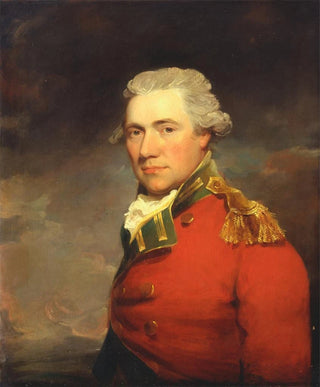Art print | An unknown British officer, probably from the 11th North Devonshire Infantry Regiment, around 1800 - John Hoppner


View from behind

Frame (optional)
Art print of an unknown British officer, probably from the 11th Infantry Regiment of North Devonshire, circa 1800 - John Hoppner – Engaging introduction
In the fascinating world of early 19th-century British art, John Hoppner's work stands out for its ability to capture not only the physical appearance of his subjects but also the very essence of their character. The art print of an unknown British officer, probably from the 11th Infantry Regiment of North Devonshire, circa 1800, perfectly illustrates this mastery. Through the intense gaze and majestic posture of this officer, Hoppner transports us to a time when honor and duty were at the heart of military life. This painting, although anonymous in its subject, carries within it the history of a nation in full transformation, an era when the British Empire was expanding and military values were celebrated.
Style and uniqueness of the work
Hoppner's work is characterized by a neoclassical style that combines rigor and sensitivity. The meticulous details of the officer's uniform, from the folds of fabric to the gilded ornaments, testify to a concern for realism that borders on photographic portraiture. The color palette, dominated by rich and deep tones, evokes an atmosphere of nobility and dignity. The artist excels in depicting faces, and the expression of the officer, both determined and melancholic, reveals a man aware of the challenges of his time. Hoppner manages to infuse an inner life into his subject, making him both identifiable and emblematic of a social class in full mutation. This painting is not just a simple military representation; it is a reflection of the aspirations and anxieties of an era.
The artist and his influence
John Hoppner, born in 1758, is often considered one of the greatest portraitists of his time. His artistic journey, marked by various influences ranging from rococo to neoclassicism, allowed him to develop a unique style that appealed to the British high society. Hoppner succeeded in establishing himself in a milieu where other artists, such as Sir Joshua Reynolds, had already set high standards. His ability to capture the personality of his

Matte finish

View from behind

Frame (optional)
Art print of an unknown British officer, probably from the 11th Infantry Regiment of North Devonshire, circa 1800 - John Hoppner – Engaging introduction
In the fascinating world of early 19th-century British art, John Hoppner's work stands out for its ability to capture not only the physical appearance of his subjects but also the very essence of their character. The art print of an unknown British officer, probably from the 11th Infantry Regiment of North Devonshire, circa 1800, perfectly illustrates this mastery. Through the intense gaze and majestic posture of this officer, Hoppner transports us to a time when honor and duty were at the heart of military life. This painting, although anonymous in its subject, carries within it the history of a nation in full transformation, an era when the British Empire was expanding and military values were celebrated.
Style and uniqueness of the work
Hoppner's work is characterized by a neoclassical style that combines rigor and sensitivity. The meticulous details of the officer's uniform, from the folds of fabric to the gilded ornaments, testify to a concern for realism that borders on photographic portraiture. The color palette, dominated by rich and deep tones, evokes an atmosphere of nobility and dignity. The artist excels in depicting faces, and the expression of the officer, both determined and melancholic, reveals a man aware of the challenges of his time. Hoppner manages to infuse an inner life into his subject, making him both identifiable and emblematic of a social class in full mutation. This painting is not just a simple military representation; it is a reflection of the aspirations and anxieties of an era.
The artist and his influence
John Hoppner, born in 1758, is often considered one of the greatest portraitists of his time. His artistic journey, marked by various influences ranging from rococo to neoclassicism, allowed him to develop a unique style that appealed to the British high society. Hoppner succeeded in establishing himself in a milieu where other artists, such as Sir Joshua Reynolds, had already set high standards. His ability to capture the personality of his






